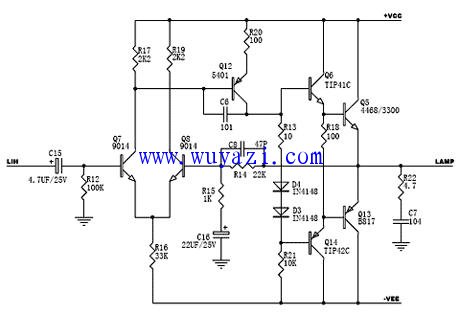The rear stage power amplifier circuit is illustrated in the image above, and it represents a custom-designed power amplifier I developed. Let's break down how it works.
Considering the left channel as an example, the signal from the previous stage is identical for both channels. This signal is then amplified by a differential input amplifier made up of transistors Q7 and Q8 via capacitor C15. The amplified signal is taken from the collector of Q7 and sent to the excitation transistor Q12 for further amplification. The excitation signal is then output in two different paths:
One path goes through resistor R13 and diodes D4 and D3 (which are forward-biased, allowing minimal AC impedance) to the base of the lower PNP composite transistor (Q14) in the complementary push-pull amplifier. During the negative half-cycle of the signal, this composite transistor turns on, allowing current to flow through the ground and the speaker connected to the negative power supply of Q13. On the positive half-cycle, the transistor turns off.
The second path sends the signal directly to the base of the NPN composite transistor (Q6). When the signal is at the positive half-cycle, Q6 turns on, allowing current to flow through the speaker to ground. This ensures that the audio signal is continuously amplified and delivered to the speaker.
The amplified signal is finally output through the emitter stages of Q5 and Q13, driving the speaker to produce sound. Capacitor C6 serves as an anti-vibration capacitor, suppressing high-frequency self-excitation that may occur in the amplifier. It also acts as a neutralization capacitor for Q12, or a feedback capacitor, helping to reduce high-frequency gain and prevent instability or oscillation. Additionally, it contributes to frequency response stability.
Resistor R22 and capacitor C7 form a capacitive load network, acting as an impedance compensation circuit for the speaker. This helps counteract the inductive nature of the speaker, ensuring better performance. The amplifier’s negative feedback is nearly pure, contributing to overall stability, preventing self-excitation, and protecting the output transistors from overvoltage, making the system safe and reliable during operation.

waterfroof silicone shrink tubing,3m cold shrink tubing,cold shrink tubing sizes,cold shrink grip,good weather resistance cold shrink 3m
Dongguan Zhonghe Electronics Co., Ltd. , https://www.zhonghesleeving.com